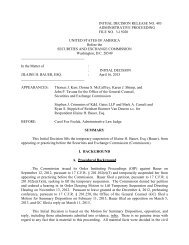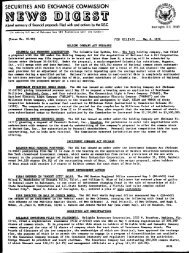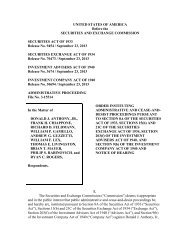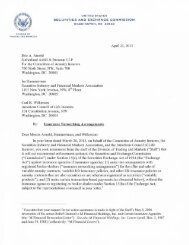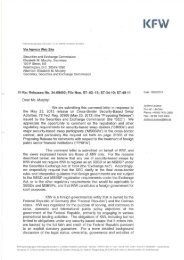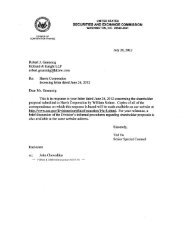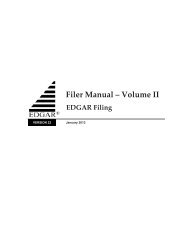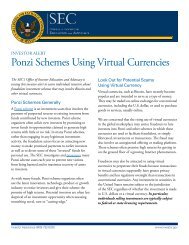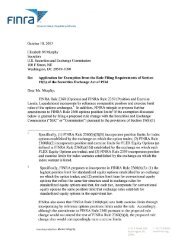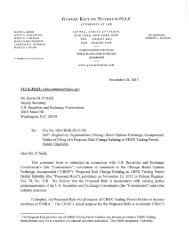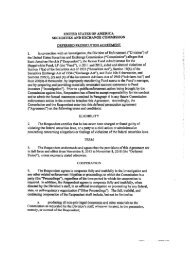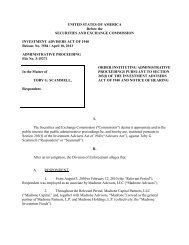Joseph J. Porco, Managing Director, Independent Asset Management
Joseph J. Porco, Managing Director, Independent Asset Management
Joseph J. Porco, Managing Director, Independent Asset Management
You also want an ePaper? Increase the reach of your titles
YUMPU automatically turns print PDFs into web optimized ePapers that Google loves.
Similarly, by definition, "consequential damages" arise not from the immediate act of the<br />
party, but in consequence of such act—such as if a person throws a log into the public<br />
streets and another falls upon it and becomes injured by the fall.10 Violative Transactions<br />
in the current matter triggered a chain of effects that resulted in numerous consequential<br />
damages. Injuries to Derivative Claimants fall under the heading of "consequential<br />
damages," both because Injured Customers passed their losses on to Derivative Claimants<br />
and because Derivative Claimants suffered further financial harm as a result of their<br />
injured track record.<br />
IAM's and IFL's clients and contacts included a pension fund, as well as other institutional<br />
and high net worth investors. Because IAM is a young firm, performance is the most<br />
critical element to growth, in terms of raising funds under management. Performance<br />
(growth) is critical both to survival and to maintaining strategic relationships with<br />
operations including, but not limited to, administration, accounting and auditing.11<br />
The NYSE Fraud robbed IAM (the trading manager), IFL (the fund) and its contacts of<br />
performance. The NYSE Fraud thereby materially damaged the ability of IAM and IFL to<br />
raise assets from 2003 through 2005. 2 During this very period, the rest of the hedge<br />
fund/alternative investment sector experienced explosive and unprecedented growth.<br />
Moreover, as investors began to withdraw their funds from IFL, and as assets under<br />
management declined, management fees were lost—management fees that were necessary<br />
for the principals of IAM personally to survive. Therefore, besides diminishing the<br />
performance generated by Sea Carriers, the NYSE Fraud set off a wave of related events<br />
that drove IAM to the brink of financial ruin and in doing so caused IAM's principals and<br />
10 See id. at 163.<br />
11 Despite its relative youth, IAM quickly established a strong reputation, until the NYSE Fraud took this<br />
major asset away. Before founding LAM, George Szele worked at Societe Generale, Goldman Sachs, and<br />
State Street Global Advisors. Raising the capital to found IAM, setting up a premier team of administrators<br />
and accountants, setting up an office in Stamford, and securing the necessary regulatory registrations—all<br />
these accomplishments directly resulted from hard work and the reputation George had nurtured over ten<br />
years. In buildinga fully scalablebusiness, whichcouldhandle assetsup to $1 billion, the principalsofIAM<br />
negotiated and secured contracts with companies regarded by investors as "pillars in the institutional<br />
community," thereby ensuring investor confidence in proper administration, reporting and auditing for the<br />
fund. IAM secured back office relationships with OSI (now part of Sungard), Forum Fund Services (now<br />
part of CitiGroup) and KPMG. Each of these groups took 1AM and the fund on with the expectation of<br />
significant growth of assets over two to three years.<br />
Specifically, as existing investors grew more and more discontent with performance, IAM began to lose<br />
credibility with its back office vendors and its administrator. OSI/Sungard was the first to resign. This event<br />
triggered concern among the remaining investors but also required LAM to spend time and effort to find a<br />
replacement administrator and in essence start over. Next, IAM's offshore administrator, Forum Fund<br />
Services, resigned. This eventcaused further concern with remaining investors and required IAM to spend<br />
the time andeffort to find a replacement offshore administrator. Remaining investors had concerns regarding<br />
performance and concerns regarding the resignations of IAM's strategic administrative partners. Then<br />
KPMG suggested that it would be mutually practical, due to the fund's size and the cost to audit the fund,<br />
that the auditing relationship be terminated. This event caused additional concern with the remaining<br />
investors and required LAM to spend the time and effort to find a replacement auditor. Each required restart<br />
consumed significant resources.



